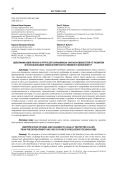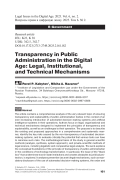Появление новых технологий неизбежно приводит к формированию новых рисков и угроз для охраняемых законом ценностей, в том числе требующих их оценки с точки зрения необходимости формирования уголовно-правовых и административно-правовых запретов как механизма исключения случаев причинения вреда личности, обществу и государству. Первым этапом такой оценки как составного элемента процесса криминализации, деликтолизации деяний выступает идентификация соответствующих рисков и угроз для охраняемых законом ценностей. Идентификация, классификация, систематизация рисков и угроз для охраняемых законом ценностей, порождаемых развитием и использованием технологий искусственного интеллекта, предполагает определенность в вопросе о сущности и содержании технологий искусственного интеллекта как источника рисков и угроз. Между тем наличествуют объективные факторы в виде неопределенности в технических, экономических, политических и юридических науках содержания соответствующей категории. В статье доказана необходимость уточнения совокупности рисков и угроз, охраняемых законом ценностей, порождаемых развитием и использованием технологий искусственного интеллекта, по мере уточнения содержания соответствующей категории в доктрине и позитивном праве. Выявлены источники рисков и угроз для охраняемых законом ценностей. Доказано, что бесконтрольное расширение применения технологий искусственного интеллекта может привести к изменению социального ландшафта, что ставит задачу должного правового опосредования и формирования гарантий прав и законных интересов граждан, организаций, органов публичной власти. Показана роль неправомерного вмешательства в функционирование интеллектуальных систем, использующих технологии искусственного интеллекта. Определены потенциальные угрозы, связанные со злонамеренным использованием технологий искусственного интеллекта в противоправных целях.
The article contains a comprehensive analysis of the very relevant topic of ensuring transparency and explainability of public administration bodies in the context of an ever-increasing introduction of automated decision-making systems and artificial intelligence systems in their operations. Authors focus on legal, organisational and technical mechanisms designed to implement the principles of transparency and explainability, as well as on challenges to their operation. The purpose is to describe the existing and proposed approaches in a comprehensive and systematic manner, identify the key risks caused by the non-transparency of automated decisionmaking systems, and to evaluate critically the potential that various tools can have to minimise such risks. The methodological basis of the study is general scientific methods (analysis, synthesis, system approach), and private-scientific methods of legal science, including legalistic and comparative legal analysis. The work explores the conceptual foundations of the principle of transparency of public administration in the conditions of technology transformation. In particular, the issue of the “black box” that undermines trust in state institutions and creates obstacles to juridical protection, is explored. It analyses preventive (ex ante) legal mechanisms, such as mandatory disclosure of the use of automated decision-making systems, the order and logic of their operation, information on the data used, and the introduction of preaudit, certification and human rights impact assessment procedures. Legal mechanisms for ex post follow-up are reviewed, including the evolving concept of the “right to explanation” of a particular decision, the use of counterfactual explanations, and ensuring that users have access to the data that gave rise to a particular automated decision. The authors pay particular attention to the inextricable link between legal requirements, and institutional and technical solutions. The main conclusions are that none of the mechanisms under review are universally applicable. The necessary effect may only be reached through their comprehensive application, adaptation to the specific context and level of risk, and close integration of legal norms with technical standards and practical tools. The study highlights the need to further improve laws aimed at detailing the responsibilities of developers and operators of the automated decision-making system, and to foster a culture of transparency and responsibility to maintain public administration accountability in the interests of society and every citizen.

